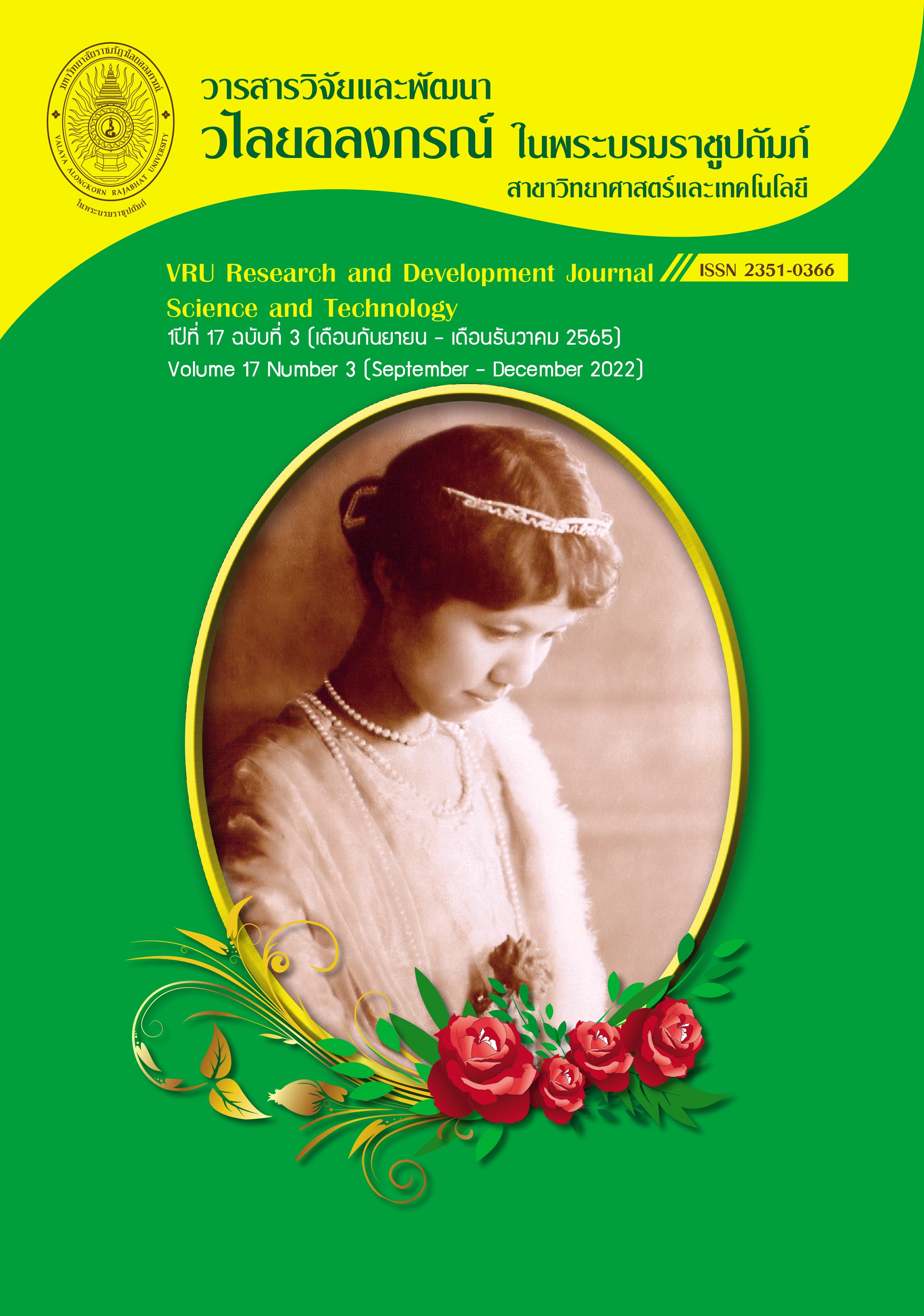THE DEVELOPMENT OF WOVEN FABRIC MIXED WITH SUGAR PALM (ARENGA PINNATA WERR) PEDUNCLE'S FIBER
Main Article Content
Abstract
The purposes of this research were 1) to study the physical properties of woven fabric mixed with sugar palm peduncle’s fiber and 2) to study satisfaction with woven fabric mixed with sugar palm peduncle’s fiber. The results showed the development of woven fabrics by using the sugar palm peduncle’s fiber as weft yarns and cotton as warp. The surface of woven fabrics was slightly glossy and had a rather rough texture. Therefore, woven fabrics are suitable for use in the development of decorative textile products or to create a unique identity for community products rather than to develop into a clothing product. The woven fabric weight was 190.71+8.10 g/m2, which is classified as medium weight. The maximum tensile strength of warp and weft yarns was 254.08+8.52 Newton and 433.12+9.45 Newton. The woven fabric had a thread count of 78 threads per inch2, and the number of warp yarns and weft yarns equal 31 and 47 threads per inch2, respectively. According to the survey, the satisfaction with the woven fabric had the highest average scores in all aspects. The overall satisfaction had the highest average scores and statistically significant differences at the 0.05 level from satisfaction with color, appearance, fabric weight, and the contact surface area.
Downloads
Article Details
ลิขสิทธิ์บทความวิจัยที่ได้รับการตีพิมพ์เผยแพร่ในวารสารวิจัยและพัฒนา วไลยอลงกรณ์ ในพระบรมราชูปถัมภ์ ถือเป็นกรรมสิทธิ์ของสถาบันวิจัยและพัฒนา มหาวิทยาลัยราชภัฏวไลยอลงกรณ์ ในพระบรมราชูปถัมภ์ ห้ามนำข้อความทั้งหมดหรือบางส่วนไปพิมพ์ซ้ำ เว้นแต่จะได้รับอนุญาตจากมหาวิทยาลัยเป็นลายลักษณ์อักษร
ความรับผิดชอบ เนื้อหาต้นฉบับที่ปรากฏในวารสารวิจัยและพัฒนา วไลยอลงกรณ์ ในพระบรมราชูปถัมภ์ เป็นความรับผิดชอบของผู้นิพนธ์บทความหรือผู้เขียนเอง ทั้งนี้ไม่รวมความผิดพลาดอันเกิดจากเทคนิคการพิมพ์
References
กองการศึกษาเทศบาลตำบลบางเตย. (2560). การทำลูกชก. สืบค้นจาก http://www.bangtoeycity.go.th/news/doc_download/a_310517_093413.pdf
กิตติพงศ์ พัฒนไพศาลสิน, กัลทิมา เชาว์ชาญชัยกุล, และแววบุญ แย้มแสงสังข์. (2562). การปรับปรุงเส้นใยจากต้นปุดสำหรับการประยุกต์ใช้งานด้านสิ่งทอ. การประชุมวิชาการเสนอผลงานวิจัยระดับ
บัณฑิตศึกษาแห่งชาติ ครั้งที่ 20, วันที่ 15 มีนาคม 2562. มหาวิทยาลัยขอนแก่น.
จุฑามาศ ขุนไชยการ, สาคร ชลสาคร, และรัตนพล มงคลรัตนาสิทธิ์. (2561). สมบัติทางกายภาพของผ้ายกเดนิมนคร. วารสาร มทร. อีสาน ฉบับวิทยาศาสตร์และเทคโนโลยี, 11(3), 130-143.
เจนณรงค์ แผ่นทอง และอโณทัย สิงห์คำ. (2563). การออกแบบผลิตภัณฑ์แฟชั่นร่วมสมัยจากเส้นใยต้นสาร. วารสารศิลปกรรมและการออกแบบแห่งเอเชีย, 1(1), 78-94.
เตือนใจ ปิยัง และระริน เครือวรพันธุ์. (2562). การสร้างมูลค่าเพิ่มจากวัสดุเหลือทิ้งในการแปรรูปทางจาก ชุมชนบ้านแหลม จังหวัดตรัง. วารสารวิจัยเพื่อการพัฒนาเชิงพื้นที่. 11(6), 503-517.
ธวัชชัย จิตวารินทร์ และคณะ. (2565). การสกัดและศึกษาคุณสมบัติเส้นใยก้านช่อดอกชก. PSRU Journal of Science and Technology, 7(2), 42-56.
นวัทตกร อุมาศิลป์ และพัดชา อุทิศวรรณกุล. (2561). นวัตกรรมสิ่งทอจากเส้นใยดาหลาสู่การออกแบบผลิตภัณฑ์แฟชั่นไลฟ์สไตล์. Veridian E-Journal Silpakorn University, 11(3), 803-814.
นาวี เปลี่ยวจิตร์. (2562). การวิจัยเส้นใยจากกาบหมากเพื่อพัฒนาเป็นเคหะสิ่งทอ. วารสารวิจัยรำไพพรรณี, 13(3), 90-100.
รุ่งทิพย์ ลุยเลา. (2560). เทคโนโลยีและนวัตกรรมเพื่อการพัฒนาเส้นใยธรรมชาติจากพืช เล่มที่ 4 : ผ้าไม่ทอจากใยธรรมชาติ. กรุงเทพฯ: สถาบันพัฒนาอุตสาหกรรมสิ่งทอ.
ศรัณย์ จันทร์แก้ว. (2562). การพัฒนาเส้นใยใบอ้อยเพื่องานออกแบบสิ่งทอ. ดุษฎีนิพนธ์ปรัชญาดุษฎีบัณฑิตคณะศิลปกรรมศาสตร์, มหาวิทยาลัยบูรพา.
สมพร วาสะสิริ. (2558). ผืนผ้าจากเส้นใยผักตบชวาผสมด้ายฝ้าย. Journal Art Klong Hok, 2(1), 210-214.
สาวิตรี สุวรรณสถิตย์. (2556). สารานุกรมไทยสำหรับเยาวชน โดยพระราชประสงค์ในพระบาทสมเด็จพระเจ้าอยู่หัว เล่ม 21. กรุงเทพฯ : มูลนิธิโครงการสารานุกรมไทยสำหรับเยาวชน โดยพระราชประสงค์ในพระบาทสมเด็จพระบรมชนกาธิเบศร มหาภูมิพลอดุลยเดชมหาราชบรมนาถบพิตร.
เสาวณีย์ อารีจงเจริญ, นฤพน ไพศาลตันติวงศ์, รัตนพล มงคลรัตนาสิทธิ์, และสาคร ชลสาคร. (2556). รายงานการวิจัย: การพัฒนาผลิตภัณฑ์สิ่งทอจากเส้นใยตะไคร้. กรุงเทพฯ: มหาวิทยาลัยเทคโนโลยีราชมงคลพระนคร.
American Society for Testing and Materials. (2008). Standard Test Methods for Warp (End) and Filling (Pick) Count of Woven Fabrics. West Conshohosken: ASTM international.
American Society for Testing and Materials. (2009a). Standard Test Methods for Mass Per Unit Area (weight) of Woven Fabric. Section 9 option C. Volume 07.02. West Conshohosken: ASTM international.
American Society for Testing and Materials. (2009b). Standard Test Method for Breaking Strength and Elongation of Textile Fabrics (Grab Test). West Conshohosken: ASTM international.
Perreault W. Jr., Cannon, J., & McCarthy, E. J. (2013). Basic Marketing : A Marketing Strategy Planning Approach. 19th ed. Irwin: McGraw-Hill.
Sapuan, S.M., Sahari, J., Ishak, M.R., & Sanyang, M.L. (2019). Sugar Palm Biofibers, Biopolymers, and Biocomposites. Florida: CRC Press.
Subhankar, M. (2014). Characteristics and effects of fiber crimp in nonwoven structure. Journal of the textile association, 3(14), 360-366.
University of Fashion. (2014). Fabric Weight. Retrieved from https://www.universityoffashion.com/wp- content/uploads/2014/12/KnitFabricWeightChart.pdf

